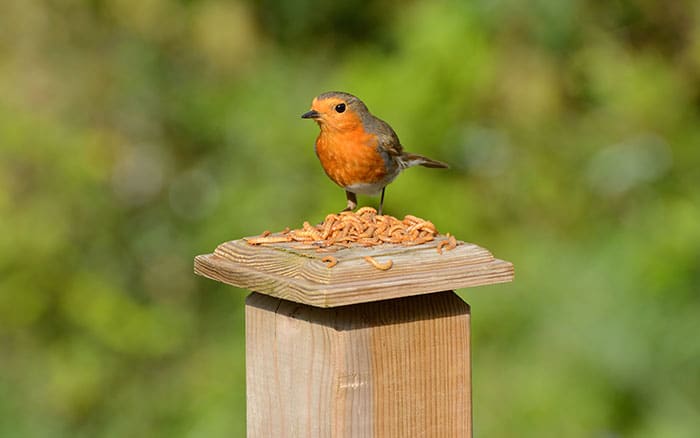Attracting wildlife into the garden is a lovely way to bring your garden to life, as well as looking after some beautiful creatures that are at risk of being endangered. Nothing quite beats the fluttering of wings and symphony of birdsong that birds can bring to your garden. Not only are they often very beneficial for your plants, some species of birds are now in danger of extinction due to population and habitat declines. fat balls
To help out our flying friends, you can provide places for them to live, such as bird boxes, and you can feed them, which is especially important over winter when food is scarce. Bird fat balls are a fantastic source of energy for birds, and whilst you can easily buy them from garden centres – it’s easy and fun to make your own.
The benefits of having birds in the garden:
There are loads of benefits to inviting birds into your garden. From a gardener’s perspective, they are great for both weed control and insect control. Finches and sparrows especially like to eat weed seeds, which will help to reduce the spread of weeds around your garden.
Lots of birds also eat insects such as spiders, which might not be welcome in your garden.
Birds are also a vital cog in the vast pollinating machine which our ecosystem depends on. Effective pollination keeps your plants happy and blooming.

On top of this, birds will be a great aesthetic and sensory addition to your garden, as birds are beautiful creatures that are amazing to watch and listen to. Why not educate your kids about nature and the different species of birds that visit your garden? They’ll be thrilled to have loads of new pets, and can even help you making your fat balls, as it is a great activity for all the family.
You Will Need:
- Lard
- Bird seed
- A mixing bowl
- String
- Old, clean yogurt pots
Prepare your ingredients. In terms of the seed, I like to blend together dried cranberry, pumpkin seeds, muesli and mealworm, but you can also buy bird seed from many garden centres and pet shops if you don’t want to mix your own. Don’t use desiccated coconut or cooked oats, as these can be harmful to birds.
You will need two parts seed to one part lard.

Tip:
You could try moulding your mix into Christmas decorations to bring robins into your garden in December.
Step Two Fat Balls
Mix your bird seed and lard together in a large bowl. You can use spoons, but I prefer to use my hands!
Push the seeds into the lard to blend them together, and the fat will bind the loose seed. You’re aiming for an even spread of feed through the lard to make a fat ball that will be stable enough.
Step Three
Now this part is entirely up to you. You can either make spherical balls or shapes on their own, that you’ll then hang from string, or you can push the mix into yoghurt pots.
To make the balls you want to use your hands to create a sphere, and then split it in half. Tie a knot in some string to make a loop, embed it and then press the ball back together.

For the yoghurt containers, poke a hole in the bottom of the pot and tie a string inside so it’ll hang upside down. Then fill the pot with the mix. You can also attach the string onto the lip of the pot, if you’d rather it hang sideways.
Step Four
Put your fat balls in the fridge for a few hours until they harden up, and then they’ll be ready to hang.
Choose a tree or shrub with easy access for birds and don’t put too many out at a time, as uneaten food will attract pests. You can also pop them in a bird feeder, if you have one. Never wrap your fat balls in plastic netting as the birds can easily get their feet trapped in the netting.

Put some fresh water out too, for the birds to keep hydrated all year through.
Once your fat balls are hanging up, you can try to spot and identify the different types of birds that visit your garden.
If you’re not sure about an unusual species of bird that has been visiting your garden, you can look it up using online bird identifiers. Watching from an indoor window will mean you might see some more unusual and timid birds.
Gradually, if they see your garden as a safe place, they will get more confident and comfortable with your presence, but don’t expect this to happen straightaway!


I loved feeding the birds but the dropped seed attracted rats I’m petrified of rats and mice so stopped feeding the birds but I miss not see the birds in my garden is there a way I can feed the birds without having rats or mice in my garden xx
The best way is to keep food topped up little and often, so that visiting birds opt to clear up any spilt or leftover first, before tucking into your topped up feeders. This will reduce waste which attracts pests.
Can you use Crisco instead of lard?
As Crisco products can contain more oil in the ingredients, it may not be advisable to use this product when making bird fat balls as the soft fats can easily be smeared onto the feathers, destroying the waterproofing and insulating qualities.
Thank guys. There are plenty of commercial fat balls I can buy online and from bird stores, but it is cheaper to make DIY bird seed balls. I can do this thanks for your article. It helps me a lot.
During winter nights, birds get their energy from their stored fat, and they will lose about 75% of this supply overnight. Thus, they need to replenish their fat stores daily.